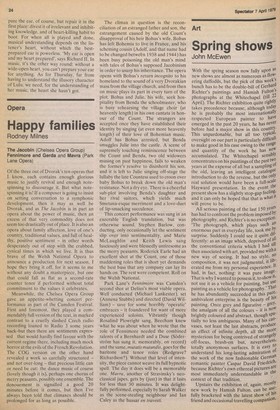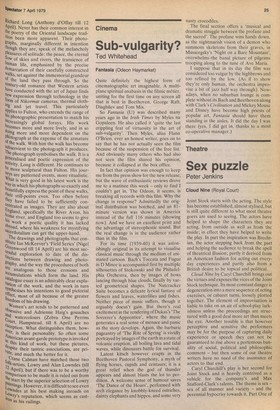Spring shows
John McEwen
With the spring season now fully upon us new shows are almost as numerous as flowering daffodils, but the pick of this week's bunch has to be the double-bill of Gerhard Richter's paintings and Hamish Fulton's photographs at the Whitechapel (till 22 April). The Richter exhibition quite rightlY takes precedence because, although today he is probably the most internationally respected European painter to have emerged in the past 20 years, he has never before had a major show in this country. This unpardonable, but all too typical' oversight on our part is particularly to make good in his case owing to the range and quantity of the work he has noW accumulated. The Whitechapel sensibly concentrates on his paintings of the past two years at the expense of all but a samPling °f the old, leaving an intelligent catalogue introduction to do the reverse, but the onlY real solution would have been a full-scale Hayward presentation. In the event the present show has a slightly stop-gap feeling, and it can only be hoped that that is what it will prove to be. difficult All serious painting of the last 150 years has had to confront the problem imposed bY photography, and Richter's is no exception. 'The photograph, which plays such all enormous part in everyday life, took me bY surprise. Suddenly I could see it quite differently: as an image which, deprived of all the conventional criteria which I had till then associated with art, provided me with a new way of seeing. It had no style, n° composition, it was not judgmental, it lib" erated me from my personal experience. It had, in fact, nothing: it was pure imag,e; That is why I wanted to possess it, to show IL. not use it as a vehicle for painting, but use painting as a vehicle for photography.' That he has abundantly succeeded in this Put!' ambivalent enterprise is the beauty of his painting. Once grey and figurative — greY' the amalgam of all the colours — it is now brightly coloured and abstract, though spatially no less ambiguous. Many of his canvases, not least the last abstracts, produce an effect of infinite depth, all the more mysterious for being contrived of strangel off-focus, brush-on but, nevertheless, totally anonymous surfaces. It is easY understand his long-lasting admiration 01 the work of the now fashionable German romantic painter Caspar David Friedrich, because Richter's own ethereal pictures are most immediately understandable in the context of that tradition. Upstairs the exhibition of, again, mosrlY new work by Hamish Fulton, can be usefully bracketed with the latest show of his friend and occasional travelling companion, Richard Long (Anthony d'Offay till 12 April). Never has their common interest in the poetry of the Oriental landscape tradition been more apparent. Their photographs, marginally different in intention though they are, speak of the melancholy Pleasures of solitude: the peace, the eternal flow of skies and rivers, the transience of human life, emphasized by the precise demarcation of their carefully constructed Walks, set against the immemorial grandeur of the land they pass through. So the century-old romance that Western artists have conducted with the art of Japan finds aew expression through technology in the form of Nikormat cameras, thermal clothMg and jet travel. This particularly ,aPPlies to Fulton, who extends the range of !as photographic presentation to match his Increasingly global forays. His work ,becomes more and more lively, and in so u,opg more and more dependent on the Photograph at the expense of the armature of the walk. With him the walk has become sUbservient to the photogiaph it produces. The photograph symbolises the walk. It is a generalised and poetic expression of the Lactivity. Long is different. He continues to ue more sculptural than Fulton. His journeys are patterned events, more ritualistic. What is very good in his latest work is the `i_vay in which his photographs so exactly and ueautifully express the point of these walks. thkeir still-points even. Too often before t'icy have failed to be sufficiently concentrated as images. They are also about ingland, specifically the River Avon, his h. me river, and England too seems to give Ins work a poetic quality it has lacked abroad, where his weakness for mystifying sacerdotalism can get the upper-hand. ,The drawings and photographs that constitute Ian McKeever's 'Field Series' (Nigel Greenwood till 14 April) are his most suc,cc. ssful exploration to date of the disonetions between drawing and photograPhy, and the way the procedures of both are analogous to those erosions and accumulations which form the land. His catalogue essay is an admirably clear explanation of the work, and the work in turn SYnthesises his intentions to good pictorial :fleet, most of all because of the greater treedom of his drawing. ,Women's art tends to be patterned and °°sessive and Adrienne Haig's gouaches r,..and watercolours (Zebra One Perrins s-uurt. Hampstead, till 8 April) are no eXception. What distinguishes them, howeyer, is their personality. So often some l‘nterican avant-garde prototype is invoked (11 this kind of work, but these pictures, vesPite their tantric associations, are priate, and much the better for it. ,Crane Calman have matched those two 14-artists, Lowry and Alan Lowndes (till 2 April), but if there was to be a worthy t, nliparison to be made it is ruled out from "! start by the superior selection of Lowry ratntings. However, it is difficult to see even r°yndes at his best making inroads on wrY's reputation, which seems as castton as his railings.



































 Previous page
Previous page